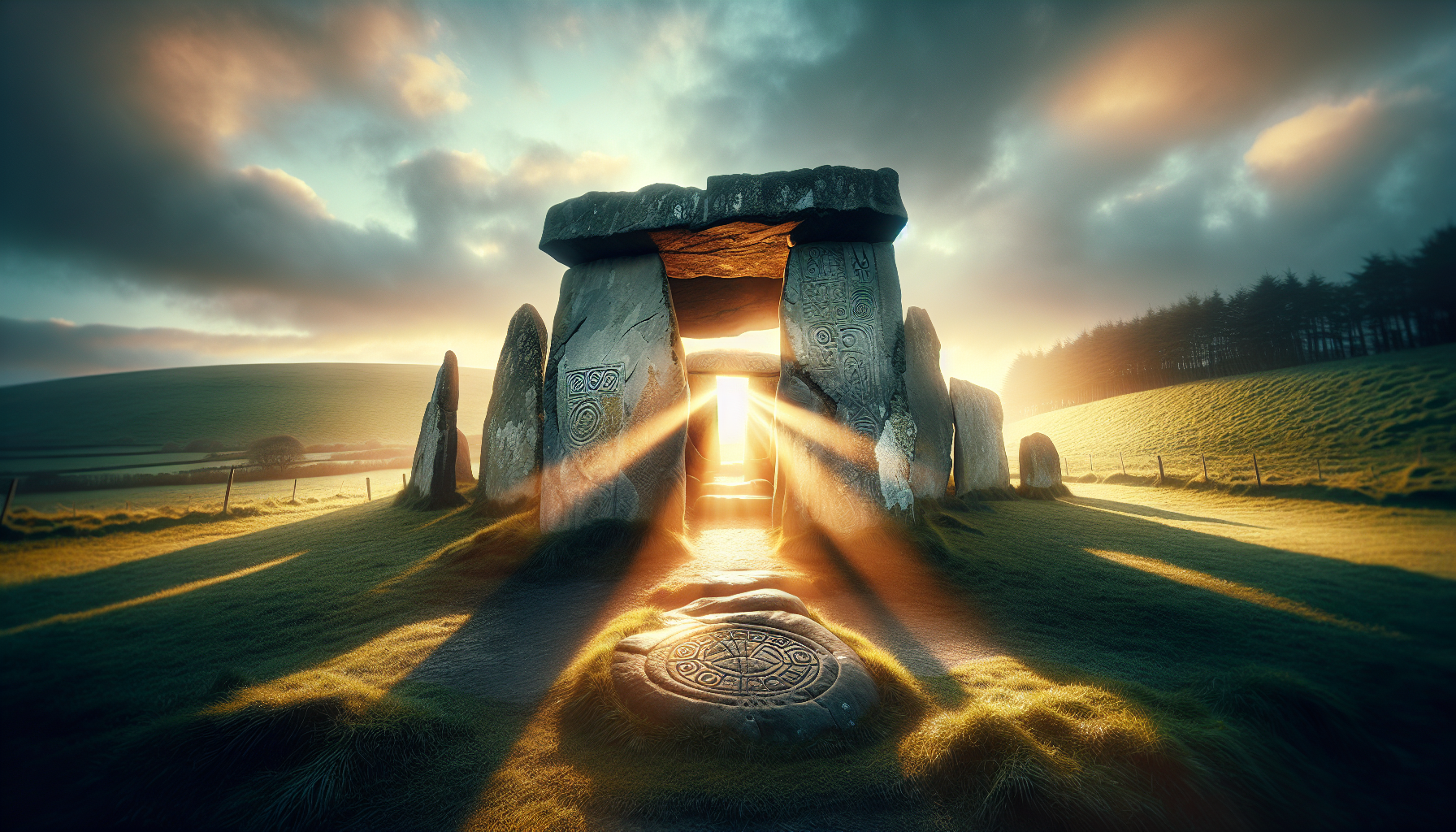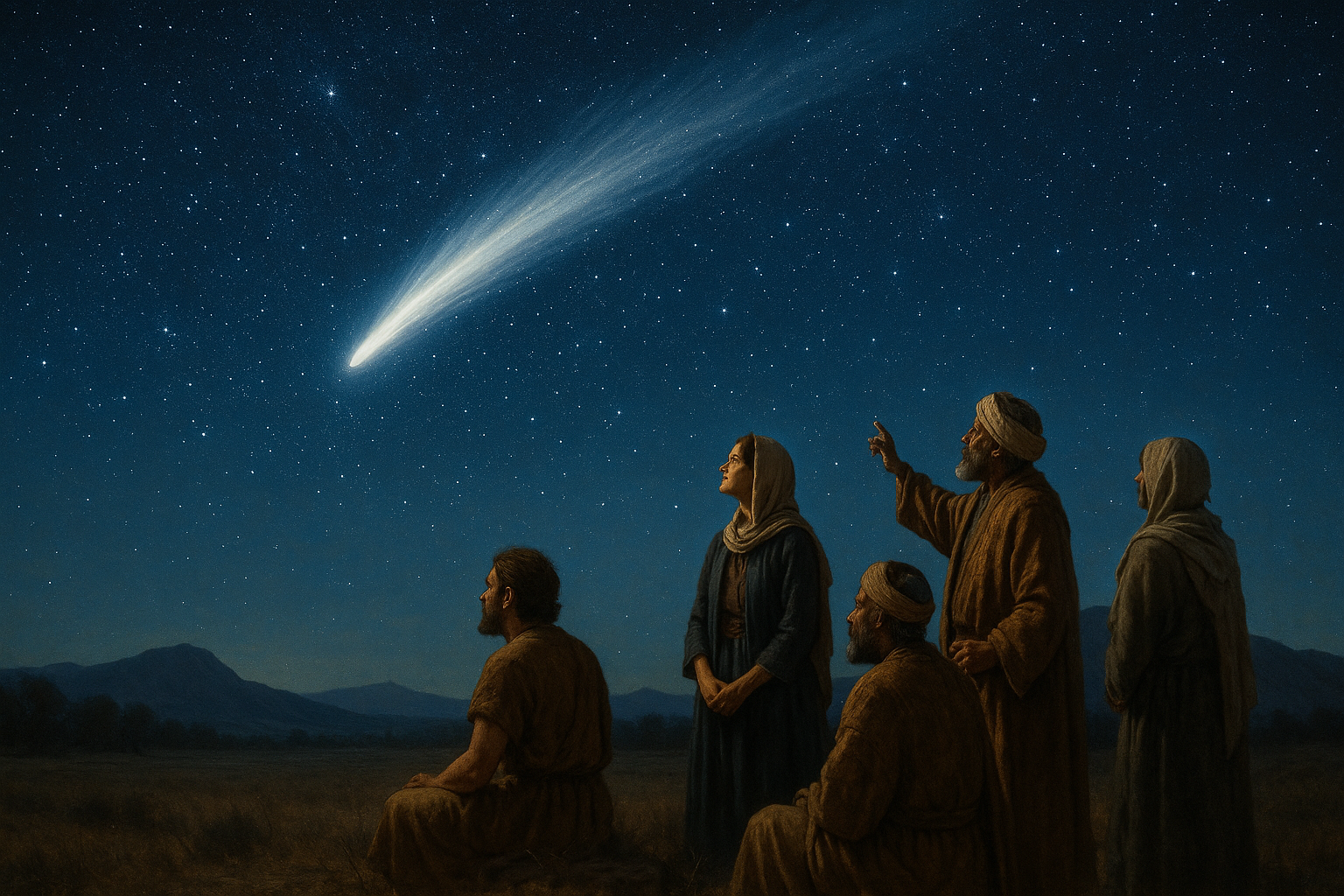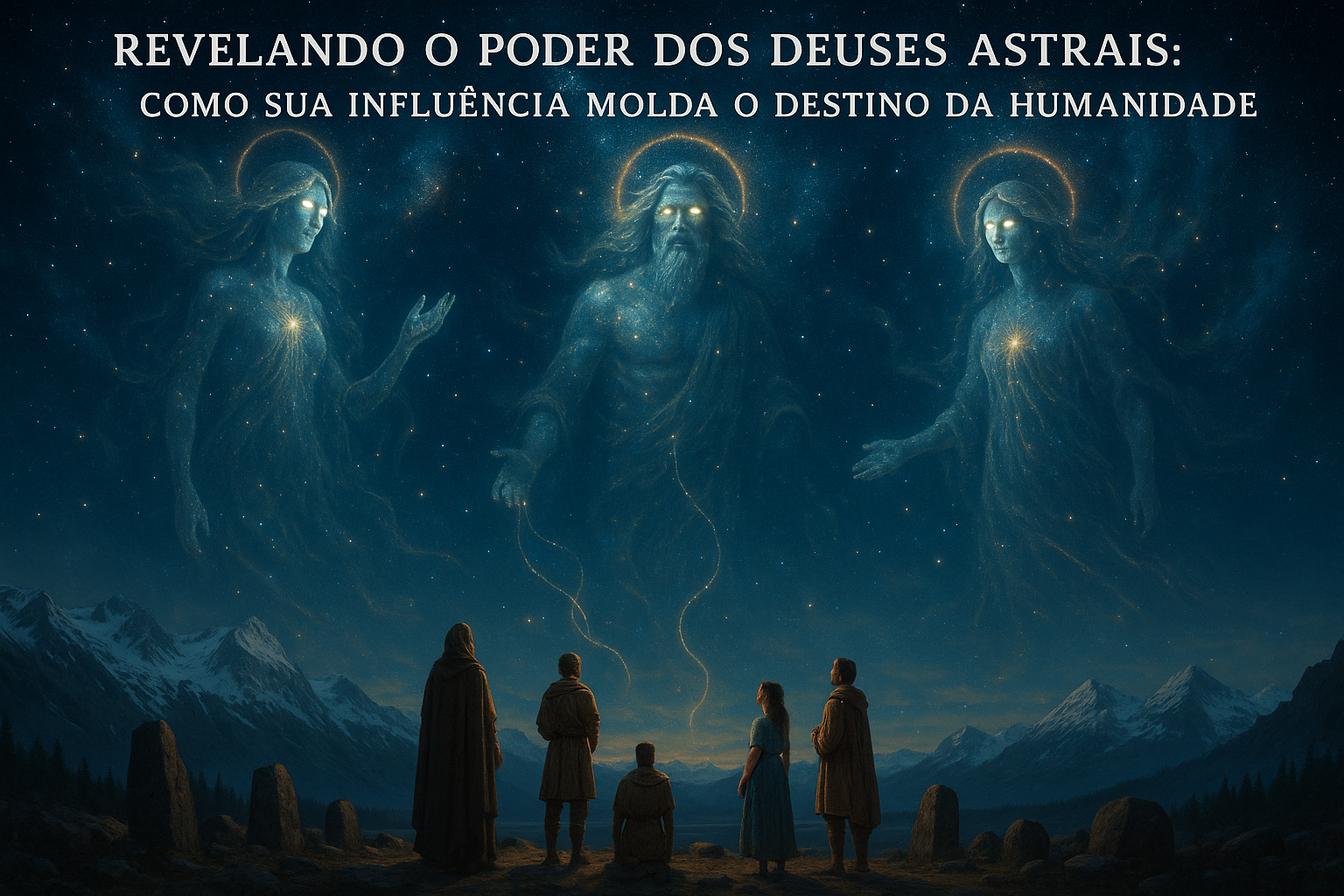In the lush, rolling hills of County Meath, Ireland, lies a marvel of ancient engineering and astronomical precision that has fascinated historians, archaeologists, and tourists alike for centuries: Newgrange. This imposing structure, older than both Stonehenge and the Great Pyramids of Giza, is not only a testament to the ingenuity of our ancestors but also a gateway to understanding their profound connection with the cosmos. As we embark on this journey to unlock the mysteries of Newgrange, we delve into the intricate solar alignments and celestial phenomena that reveal the sophisticated knowledge of the Neolithic people who once called this place sacred. 🏺
The allure of Newgrange begins with its sheer size and structure. This passage tomb, constructed over 5,000 years ago, is an architectural masterpiece featuring a vast circular mound with a long passage and a chambered interior. But what truly sets Newgrange apart is its precise alignment with the sun, which transforms this stone monument into a celestial observatory. Each year, during the winter solstice, a beam of sunlight penetrates the passage and illuminates the inner chamber, a dramatic event that signals both the triumph of light over darkness and the cyclical nature of life. This extraordinary phenomenon invites us to explore the reasons behind such an alignment and the significance it held for the ancient builders. 🌞
As we uncover the secrets of Newgrange, we’ll explore the latest archaeological findings and theories that shed light on the purpose and construction of this enigmatic site. From the painstaking craftsmanship evident in its megalithic art to the alignment’s potential links to ancient rituals and beliefs, Newgrange offers a window into a world where astronomy, spirituality, and community were intricately intertwined. We’ll examine how these elements might have influenced the daily lives and spiritual practices of the people who constructed this monument, offering us a glimpse into their worldview and their reverence for the cosmos. 🏛️
Join us as we navigate the fascinating confluence of science, history, and mythology that surrounds Newgrange. By piecing together the evidence left behind, we aim to paint a vivid picture of a culture that thrived on observation and reverence for the natural world. Through this exploration, we hope to not only appreciate the ingenuity of our ancestors but also recognize the timeless allure of humanity’s quest to understand its place in the universe. Let the journey to uncover the mysteries of Newgrange inspire you to look to the stars, just as the ancients once did. 🌌
The Enigmatic Newgrange: A Journey Through Time
Newgrange, a marvel of ancient engineering, stands proudly in the Boyne Valley, Ireland. This prehistoric monument, dating back over 5,000 years, predates Stonehenge and the Great Pyramids of Giza. Its construction, attributed to the Neolithic people, speaks volumes about their sophisticated understanding of astronomy, architecture, and art. Today, Newgrange is renowned for its winter solstice solar alignment, drawing visitors and researchers alike to its mysterious chambers.
The site comprises a large circular mound, surrounded by a ring of kerbstones and a stone passageway that leads to a central chamber. The mound itself is about 85 meters in diameter and 13 meters high, with a passage that extends 19 meters inward. But Newgrange is more than just a burial site; it serves as a testament to the astronomical acumen of its builders. The winter solstice alignment is a focal point, where the rising sun illuminates the inner chamber, a phenomenon that occurs just once a year. This precise alignment with the sun has captivated archaeologists and historians, prompting extensive studies and debates.
For those interested in exploring Newgrange further, the following video offers an in-depth visual journey into its history and significance: Unlocking the Secrets of Newgrange by National Geographic.
The Solar Alignments: A Glimpse into Ancient Astronomy
The solar alignment of Newgrange is perhaps its most intriguing feature. During the winter solstice, a beam of sunlight penetrates the long passageway and lights up the central chamber. This alignment is not accidental; it is a deliberate design that reflects the builders’ deep understanding of the solar cycles. Such precision in alignment indicates that the Neolithic people had advanced knowledge of astronomy, which they incorporated into their spiritual and daily lives.
Modern technology has allowed researchers to study this alignment in detail. By using computer simulations and laser scanning, archaeologists have confirmed the intentional design of the monument to capture the solstice sun. This discovery has sparked discussions on the possible reasons for this alignment. Was it a calendar to mark the changing seasons, a spiritual ritual, or perhaps a combination of both? While the exact purpose remains speculative, the significance of the solstice to the builders of Newgrange is undeniable.
To visualize the differences in solar alignment among other megalithic sites, see the table below:
| Monument | Location | Solar Event | Alignment |
|---|---|---|---|
| Newgrange | Ireland | Winter Solstice | Sunrise |
| Stonehenge | England | Summer Solstice | Sunset |
| Machu Picchu | Peru | Winter Solstice | Sunrise |
These alignments suggest that ancient cultures across the globe shared a common fascination with the sun and its cycles. The sophistication of Newgrange’s design is a testament to the intellectual achievements of its builders.
Decoding the Symbolism: Art and Meaning in Newgrange
Beyond its astronomical significance, Newgrange is adorned with intricate carvings and symbols. The most famous of these is the triple spiral, or triskele, which appears at the entrance and throughout the site. This symbol, along with others like concentric circles and zigzags, provides a glimpse into the artistic expression and cultural beliefs of the Neolithic people.
The meaning of these symbols remains elusive, but they likely held religious or ceremonial significance. Some scholars suggest that the spirals represent the cyclical nature of life and death, a fitting motif for a tomb. Others propose that these carvings were part of a ritualistic practice, perhaps serving as a guide for the souls of the deceased. Regardless of their exact meaning, the artistry of Newgrange is a remarkable achievement, showcasing the creativity and skill of its builders.
In addition to the carvings, Newgrange features other symbolic elements, such as the white quartz facade that would have gleamed brightly in the sunlight. This striking appearance may have had spiritual implications, enhancing the monument’s role as a sacred site. As we continue to study Newgrange, these artistic elements provide invaluable clues about the beliefs and values of its creators.
Modern Interpretations: The Ongoing Research and Discovery
The mysteries of Newgrange continue to captivate modern researchers. With advances in technology, new methods of investigation have emerged, allowing for a deeper understanding of this ancient site. Techniques such as ground-penetrating radar, 3D modeling, and infrared scanning have revealed new insights into the construction and purpose of Newgrange.
One of the most significant discoveries in recent years is the understanding of the broader landscape around Newgrange. Archaeologists have uncovered evidence of additional structures and ceremonial sites, suggesting that Newgrange was part of a larger ritual complex. This has led to a reevaluation of the social and cultural dynamics of Neolithic Ireland, shedding light on the interconnected nature of these ancient communities.
For those eager to delve into the latest research and discoveries at Newgrange, the following resources and studies offer a wealth of information:
- Exploring Newgrange: Ancient Architecture and Astronomy by Ancient Architects
- Archaeology Magazine – Search for articles on Newgrange
- Books such as “Newgrange: Archaeology, Art and Legend” by Michael J. O’Kelly
The exploration of Newgrange is a testament to the enduring human quest for knowledge and understanding. As we unlock the secrets of this ancient monument, we gain insight into the minds and lives of our ancestors, enriching our appreciation of human history and its remarkable achievements.

Conclusion
Unlocking the mysteries of Newgrange has been a captivating journey, shedding light on the profound knowledge and sophisticated engineering skills of the Neolithic people of Ireland. This ancient monument, more than 5,000 years old, continues to intrigue scholars, archaeologists, and enthusiasts alike, offering a glimpse into a world that long predates written history. As we explored in this article, Newgrange is not only an architectural marvel but also a testament to the early understanding of astronomical phenomena.
We began by examining the structure of Newgrange itself. This megalithic passage tomb, with its impressive corbelled roof and intricately carved stones, highlights the advanced construction techniques of its builders. The precision with which the monument was constructed suggests a deep understanding of engineering principles that were far ahead of their time. This structural ingenuity is matched by the artistic expressions found in the carvings, which add a layer of symbolic meaning that remains open to interpretation.
Central to our discussion was the solar alignment of Newgrange, a feature that underscores the monument’s significance as more than just a burial site. During the winter solstice, the rising sun illuminates the inner chamber, a phenomenon that demonstrates the builders’ sophisticated understanding of solar movements. This alignment is not just a technical achievement; it symbolizes renewal and the cyclical nature of life, themes that are likely to have been of deep spiritual significance to the Neolithic people.
We also delved into the cultural and historical context surrounding Newgrange. Situated in the Boyne Valley, Newgrange is part of a complex of similar sites that together form the Brú na Bóinne UNESCO World Heritage Site. This highlights its importance as a center of ritual and community life in Neolithic Ireland. The monument’s longevity and the continued interest it generates speak to its enduring power as a cultural touchstone.
In addition to these points, the article considered the broader implications of Newgrange’s solar alignments. They invite us to ponder the relationship between ancient peoples and the natural world, a relationship characterized by reverence and a desire to understand cosmic rhythms. The solar alignment at Newgrange serves as a reminder of the interconnectedness of human existence and the broader universe, a theme that resonates with contemporary concerns about environmental stewardship and sustainable living.
The exploration of Newgrange also touches on the methodologies used by modern researchers to unlock its secrets. Advances in technology, such as 3D mapping and remote sensing, have provided new insights into the construction and purpose of the monument. These tools have allowed archaeologists to uncover details without disturbing the delicate site, preserving it for future generations.
As we conclude this exploration of Newgrange, it is important to reflect on the broader significance of understanding our past. Newgrange is a reminder of humanity’s long-standing quest to comprehend the world around us. The monument’s construction and alignment reflect a sophisticated grasp of natural cycles, suggesting that the people who built it were both skilled artisans and keen observers of the heavens.
In considering the legacy of Newgrange, we are reminded of the importance of preserving such sites for future study and reflection. These ancient structures are more than historical curiosities; they are vital links to our shared human heritage. As we face contemporary challenges, the lessons of Newgrange encourage us to look to the past for guidance and inspiration.
I encourage you, dear reader, to engage with this remarkable site in whatever way you can. Whether through visiting Newgrange itself, participating in archaeological discussions, or sharing this article with others, your involvement helps to keep the story of Newgrange alive. Let us continue to explore, to learn, and to be inspired by the ingenuity and vision of our ancestors. 🌟
Please feel free to comment below with your thoughts or questions, and share this article with others who might be fascinated by the mysteries of Newgrange. Together, we can continue to uncover and appreciate the wisdom of the past.
For further exploration, you may find additional resources at these active links:
1. [Heritage Ireland: Newgrange](https://www.heritageireland.ie/en/midlandseastcoast/newgrange/)
2. [World Heritage Ireland: Brú na Bóinne](https://www.worldheritageireland.ie/bru-na-boinne/)
Thank you for joining us on this journey through time. 🌍
Toni Santos is a visual storyteller and cosmic interpreter whose work illuminates the ancient skywatchers and their prehistoric astronomy—the profound ways early humans observed and revered the heavens before written history. Through a visionary lens, Toni explores how the stars, planets, and celestial cycles shaped myth, ritual, and survival in cultures lost to time.
Rooted in a fascination with archaic observatories, stone alignments, and celestial symbolism, Toni’s creative journey reveals the deep human impulse to understand and harmonize with the cosmos. From lunar phases guiding planting seasons to the sacred paths of the Milky Way, each of his works embodies the awe and knowledge encoded in the night sky.
Combining artistic craftsmanship with archaeological insight, Toni’s pieces evoke the mystery and precision of prehistoric astronomers. His work does more than depict—it channels the timeless dance between earth and sky, bridging ancient wisdom with contemporary wonder.
As the visionary behind Vizovex, Toni shares curated visuals, essays, and symbolic studies that invite others to reconnect with the cosmic heritage written in stone and starlight. His creations are a call to look upward, to listen to the silent stories told by the stars, and to honor the first astronomers who mapped the heavens with reverence and ingenuity.
His work is a tribute to:
The celestial wisdom of prehistoric peoples
The sacred geometry of ancient observatories
The enduring bond between human culture and the cosmos
Whether you’re a stargazer, a scholar of ancient mysteries, or someone captivated by the universe’s earliest storytellers, Toni welcomes you to journey through a space where the sky is both map and myth—one constellation, one ritual, one revelation at a time.




